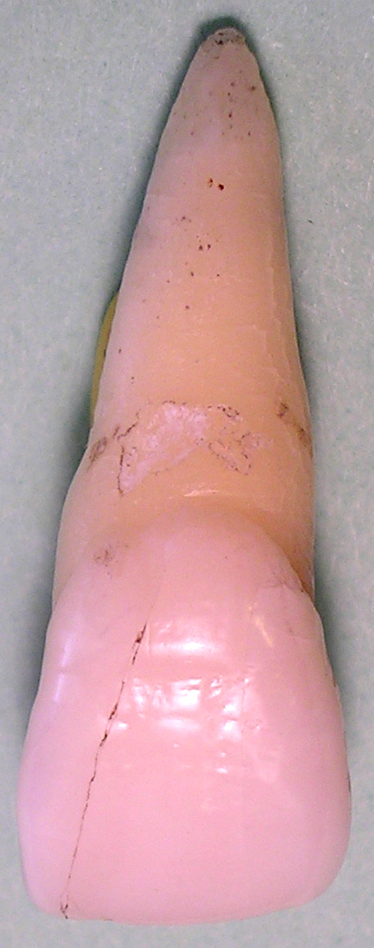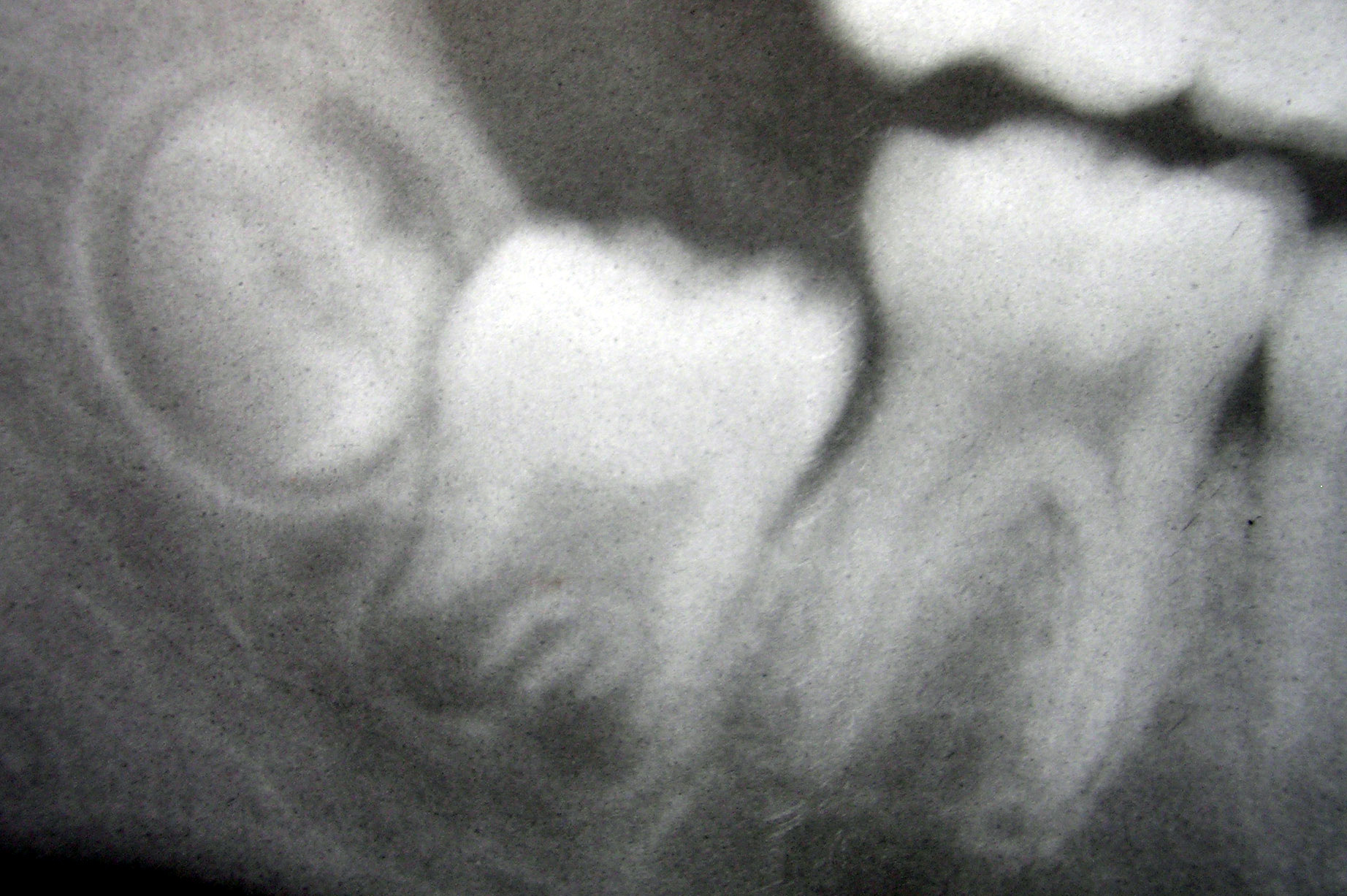|
Incisors
Incisors (from Latin ''incidere'', "to cut") are the front teeth present in most mammals. They are located in the premaxilla above and on the mandible below. Humans have a total of eight (two on each side, top and bottom). Opossums have 18, whereas armadillos, anteaters and other animals in the order Edentata have none. Structure Adult humans normally have eight incisors, two of each type. The types of incisors are: * maxillary central incisor (upper jaw, closest to the center of the lips) * maxillary lateral incisor (upper jaw, beside the maxillary central incisor) * mandibular central incisor (lower jaw, closest to the center of the lips) * mandibular lateral incisor (lower jaw, beside the mandibular central incisor) Children with a full set of deciduous teeth (primary teeth) also have eight incisors, named the same way as in permanent teeth. Young children may have from zero to eight incisors depending on the stage of their tooth eruption and Human tooth development, tooth d ... [...More Info...] [...Related Items...] OR: [Wikipedia] [Google] [Baidu] |
Shovel-shaped Incisors
Shovel-shaped incisors (or, more simply, shovel incisors) are incisors whose Glossary of dentistry, lingual surfaces are scooped as a consequence of lingual marginal ridges, Crown (tooth), crown curvature, or Basal (anatomy), basal Tubercle (anatomy), tubercles, either alone or in combination. Shovel-shaped incisors are significantly common in Indigenous peoples of the Americas, Amerindians from North America, North, Central America, Central, and South America. They are also common in East Asians and Central Asians, Inuit, and Aleut peoples of Siberian Yupik, Northeast Asia and North America (including but not limited to Inuit in eastern Alaska, Northern Canada, Arctic Canada, and Greenland). In certain European peoples, European and Demographics of Africa, African groups, shovel-shaped upper incisors are uncommon or not present. There is a spectrum of the degree of shoveled-ness, ranging on a scale from 0 to 7 of spatulate incisors to shoveled incisors. It was theorized that pos ... [...More Info...] [...Related Items...] OR: [Wikipedia] [Google] [Baidu] |
Maxillary Central Incisor
The maxillary central incisor is a human tooth in the front upper jaw, or maxilla, and is usually the most visible of all teeth in the mouth. It is located Commonly used terms of relationship and comparison in dentistry, mesial (closer to the midline of the face) to the maxillary lateral incisor. As with all incisors, their function is for Shearing (physics), shearing or cutting food during mastication (chewing). There is typically a single cusp (dentistry), cusp on each tooth, called an Commonly used terms of relationship and comparison in dentistry, incisal ridge or incisal edge. Formation of these teeth begins at 14 weeks in utero for the deciduous teeth, deciduous (baby) set and 3–4 months of age for the permanent teeth, permanent set. There are some minor differences between the deciduous maxillary central incisor and that of the permanent maxillary central incisor. The deciduous tooth appears in the mouth at 8–12 months of age and shed at 6–7 years, and is replaced b ... [...More Info...] [...Related Items...] OR: [Wikipedia] [Google] [Baidu] |
Rodent
Rodents (from Latin , 'to gnaw') are mammals of the Order (biology), order Rodentia ( ), which are characterized by a single pair of continuously growing incisors in each of the upper and Mandible, lower jaws. About 40% of all mammal species are rodents. They are native to all major land masses except for Antarctica, and several oceanic islands, though they have subsequently been introduced to most of these land masses by human activity. Rodents are extremely diverse in their ecology and lifestyles and can be found in almost every terrestrial habitat, including human-made environments. Species can be arboreal, fossorial (burrowing), saltatorial/ricochetal (leaping on their hind legs), or semiaquatic. However, all rodents share several morphological features, including having only a single upper and lower pair of ever-growing incisors. Well-known rodents include Mouse, mice, rats, squirrels, prairie dogs, porcupines, beavers, Cavia, guinea pigs, and hamsters. Once included wi ... [...More Info...] [...Related Items...] OR: [Wikipedia] [Google] [Baidu] |
Teeth
A tooth (: teeth) is a hard, calcified structure found in the jaws (or mouths) of many vertebrates and used to break down food. Some animals, particularly carnivores and omnivores, also use teeth to help with capturing or wounding prey, tearing food, for defensive purposes, to intimidate other animals often including their own, or to carry prey or their young. The roots of teeth are covered by gums. Teeth are not made of bone, but rather of multiple tissues of varying density and hardness that originate from the outermost embryonic germ layer, the ectoderm. The general structure of teeth is similar across the vertebrates, although there is considerable variation in their form and position. The teeth of mammals have deep roots, and this pattern is also found in some fish, and in crocodilians. In most teleost fish, however, the teeth are attached to the outer surface of the bone, while in lizards they are attached to the inner surface of the jaw by one side. In cartilaginous ... [...More Info...] [...Related Items...] OR: [Wikipedia] [Google] [Baidu] |
Maxillary Lateral Incisor
The maxillary lateral incisors are a pair of upper (maxillary) teeth that are located laterally (away from the midline of the face) from both maxillary central incisors of the mouth and medially (toward the midline of the face) from both maxillary canines. As with all incisors, their function is for shearing or cutting food during mastication, commonly known as chewing. There are generally no cusps on the teeth, but the rare condition known as talon cusps are most prevalent on the maxillary lateral incisors. The surface area of the tooth used in eating is called an incisal ridge or incisal edge. Though relatively the same, there are some minor differences between the deciduous (baby) maxillary lateral incisor and that of the permanent maxillary lateral incisor. The maxillary lateral incisors occlude in opposition to the mandibular lateral incisors. Notation In the universal system of notation, the deciduous maxillary lateral incisors are designated by a letter written in u ... [...More Info...] [...Related Items...] OR: [Wikipedia] [Google] [Baidu] |
Mandibular Central Incisor
The mandibular central incisor is the tooth located on the jaw, adjacent to the midline of the face. It is mesial (toward the midline of the face) from both mandibular lateral incisors. As with all incisors, its function includes shearing or cutting food during mastication, commonly known as chewing. There are no cusps on the tooth. Instead, the surface area of the tooth used in eating is called an incisal ridge or incisal edge. Though the two are similar, there are some minor differences between the deciduous (baby) mandibular central incisor and that of the permanent mandibular central incisor. The mandibular central incisors are usually the first teeth to appear in the mouth, typically around the age of 6–8 months. Notation In the universal system of notation, the deciduous mandibular central incisors are designated by a letter written in uppercase. The right deciduous mandibular central incisor is known as "P", and the left one is known as "O". The international nota ... [...More Info...] [...Related Items...] OR: [Wikipedia] [Google] [Baidu] |
Canine Tooth
In mammalian oral anatomy, the canine teeth, also called cuspids, dogteeth, eye teeth, vampire teeth, or fangs, are the relatively long, pointed teeth. In the context of the upper jaw, they are also known as '' fangs''. They can appear more flattened, however, causing them to resemble incisors and leading them to be called ''incisiform''. They developed and are used primarily for firmly holding food in order to tear it apart, and occasionally as weapons. They are often the largest teeth in a mammal's mouth. Individuals of most species that develop them normally have four, two in the upper jaw and two in the lower, separated within each jaw by incisors; humans and dogs are examples. In most species, canines are the anterior-most teeth in the maxillary bone. The four canines in humans are the two upper maxillary canines and the two lower mandibular canines. They are specially prominent in dogs (Canidae), hence the name. Details There are generally four canine teeth: two ... [...More Info...] [...Related Items...] OR: [Wikipedia] [Google] [Baidu] |
Mandibular Lateral Incisor
The mandibular lateral incisor is the tooth located distally (away from the midline of the face) from both mandibular central incisors of the mouth and mesially (toward the midline of the face) from both mandibular canines. As with all incisors, their function is for shearing or cutting food during mastication, commonly known as chewing. There are no cusps on the teeth. Instead, the surface area of the tooth used in eating is called an incisal ridge or incisal edge. Though relatively the same, there are some minor differences between the deciduous (baby) mandibular lateral incisor and that of the permanent mandibular lateral incisor. In the universal system of notation, the deciduous mandibular lateral incisors are designated by a letter written in uppercase. The right deciduous mandibular lateral incisor is known as "Q", and the left one is known as "N". The international notation has a different system of notation. Thus, the right deciduous mandibular lateral incisor k ... [...More Info...] [...Related Items...] OR: [Wikipedia] [Google] [Baidu] |
Lagomorph
The lagomorphs () are the members of the taxonomic order Lagomorpha, of which there are two living families: the Leporidae (rabbits and hares) and the Ochotonidae ( pikas). There are 110 recent species of lagomorph, of which 109 species in twelve genera are extant, including ten genera of rabbits (42 species); one genus of hare (33 species) and one genus of pika (34 species). The name of the order is derived from the Ancient Greek (, "hare") + (, "form"). Taxonomy and evolutionary history Other names used for this order, now considered synonymous, include: ''Duplicidentata'' (Illiger, 1811); ''Leporida'' (Averianov, 1999); ''Neolagomorpha'' (Averianov, 1999); ''Ochotonida'' (Averianov, 1999); and ''Palarodentia'' (Haeckel, 1895; Lilian, 2016). The evolutionary history of the lagomorphs is still not well understood. In the late 20th century, it was generally agreed that '' Eurymylus'', which lived in eastern Asia and dates back to the late Paleocene or early Eocene, was ... [...More Info...] [...Related Items...] OR: [Wikipedia] [Google] [Baidu] |
Human Tooth Development
Tooth development or odontogenesis is the complex process by which teeth form from embryonic cells, grow, and erupt into the mouth. For human teeth to have a healthy oral environment, all parts of the tooth must develop during appropriate stages of fetal development. Primary (baby) teeth start to form between the sixth and eighth week of prenatal development, and permanent teeth begin to form in the twentieth week.Ten Cate's Oral Histology, Nanci, Elsevier, 2013, pages 70-94 If teeth do not start to develop at or near these times, they will not develop at all, resulting in hypodontia or anodontia. A significant amount of research has focused on determining the processes that initiate tooth development. It is widely accepted that there is a factor within the tissues of the first pharyngeal arch that is necessary for the development of teeth. Overview The tooth germ is an aggregation of cells that eventually forms a tooth.University of Texas Medical Branch. These cells are ... [...More Info...] [...Related Items...] OR: [Wikipedia] [Google] [Baidu] |







